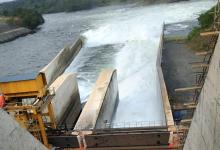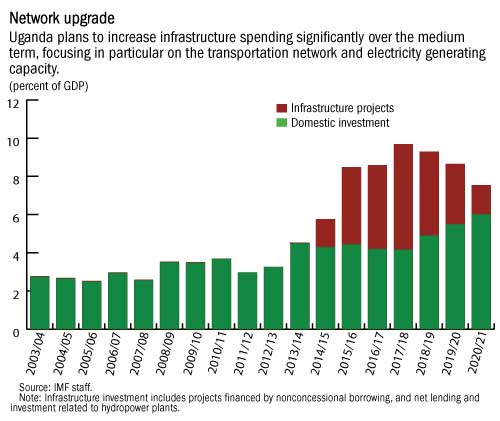
Typical street scene in Santa Ana, El Salvador. (Photo: iStock)
IMF Survey : Uganda’s Ambitious Infrastructure Plan Set to Boost Economy
July 7, 2015
- Infrastructure investment is government’s top medium-term economic priority
- Upgrade plan to be backed by sound fiscal policies, efficient project management
- Targeted social protection to help those not benefiting directly from upgrade
A ten-year, multibillion-dollar plan to upgrade Uganda’s transportation network and power generation is poised to benefit the East African nation’s citizens and those of neighboring countries, IMF economists said.

Bujagali hydroelectric power station, Uganda: new dam is part of government drive to boost electricity generation (photo: Yannick Tylle/Corbis)
ECONOMIC HEALTH CHECK
In their regular review of the Ugandan economy, IMF staff said that the planned infrastructure overhaul—an $11 billion program over the next ten years through public investment and public-private-partnership arrangements—will have positive spillovers on agro-processing, manufacturing, and trade.
Upgrading the transportation network and electricity generating capacity is now Uganda’s top economic priority. Over three fourths of Ugandans live in rural areas with most involved in agriculture, and only 14 percent of households use electricity. A comprehensive road network and widespread access to electricity will connect farmers to trading centers, add value to production, and improve the population’s welfare.
Upcoming oil production, expected to come on stream around 2021, requires new infrastructure that will be led by government investment with participation of the private sector, and will include the construction of roads, a crude oil pipeline, a small-scale refinery, and product pipelines.
Electricity surplus
Infrastructure improvements will also allow Uganda to maximize the benefits of regional integration with other East African Community partner states. Uganda’s expected electricity surplus will be exported to neighboring countries; and better roads, bridges, railways, and new pipelines will facilitate the movement of citizens across countries and the transportation of goods to seaports.
The question of how to scale up infrastructure investment while maintaining strong and sustainable economic growth, enhanced inclusion, and price stability was analyzed by the Ugandan authorities and IMF staff in preparation for the 2015 review of the economy known as the Article IV consultation.
The review concluded that favorable existing conditions should allow Uganda to embark safely on its ambitious infrastructure plan. To ensure success, however, consistent policy implementation, sound project management, and a business-friendly environment will be required.
Strong safeguards
The report found that Uganda has been able to gradually build buffers that have put the economy on a sound footing from which to launch the infrastructure program and secure its financing.
At less than 5 percent in May, the country enjoys low and stable inflation. With the help of an inflation targeting regime, the central bank successfully lowered inflation from a peak of 33 percent in 2011, by effectively influencing market interest rates and credit performance.
Uganda has low external debt and high international reserves. The authorities have prudently limited external debt’s increase to 4 percent of GDP since 2007. At 18 percent of GDP now, there is space for new borrowing to finance infrastructure investment with a low risk of creating distress.
Furthermore, international reserves cover 4 months of imports, 70 percent of broad money, and 500 percent of short-term debt, and support the envisaged foreign currency needs for infrastructure imports.
Clear fiscal principles
The economic review noted that the success of the infrastructure investment plan depends critically on fiscal policy consistency and effective project management. Infrastructure investment of 4¼ percent of GDP, on average, is projected for the construction period (see chart). To create space for this investment, the authorities plan to continue to increase tax revenue and constrain less productive spending.

Improving the quality of expenditure is crucial for budget credibility and enhanced compliance since a change in the tax-paying culture will occur only once citizens are convinced that revenues are being put to good use.
Other important principles relate to project selection and management, pace of execution, and financing terms, the report said. The authorities are selecting projects based on thorough and independent feasibility analyses that demonstrate their commercial viability. They are also determined to phase in projects properly, balancing the risk of slow implementation resulting in unnecessary costs and lower growth impact, against the risk of rapid construction that could overheat the economy.
In addition, the authorities plan to secure project financing on the best possible terms once they exhaust their domestic savings. While concessional debt is not available for all these projects, given their size, the government is securing nonconcessional loans at better-than-market financial terms.
Business-friendly environment
The report notes that to support medium-term growth, the infrastructure effort is to be accompanied by higher private sector contributions to development and a targeted focus on inclusiveness.
Private investment requires a stable and business-friendly commercial environment. Preserving economic and financial stability is therefore important to fully reap the benefits of infrastructure improvements.
Policy flexibility to quickly respond to the impact of global and regional developments on Uganda’s small and open economy is crucial. Ongoing governance improvements—including better fiduciary controls of government operations and strengthened public investment guidelines—are expected to attract further foreign and domestic investment.
Successful infrastructure improvements will increase potential economic growth and go a long way in benefiting the poor, but will need to be supplemented by efforts in other areas—namely sustained health and education investment and a well targeted social protection system—to shield those segments of the population that are too vulnerable to benefit from infrastructure upgrades.
Significant actions in all these areas are under way in Uganda, heralding a positive impact from infrastructure upgrades on the economy and on the well being of Uganda’s citizens.







